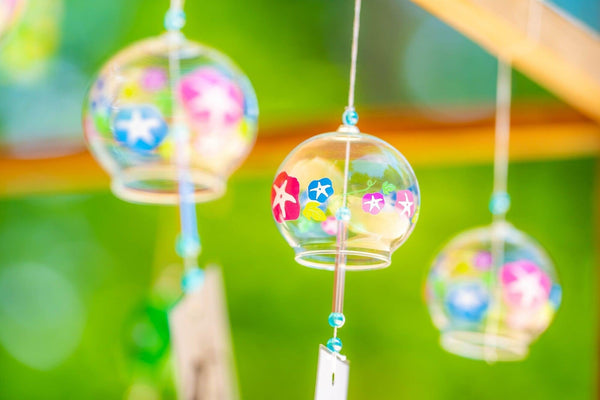
Jump to:
In Japan, if you walk through a town on a breezy day, you just might hear the sound of wind chimes in the air. Japan has been using wind chimes (also known as furin or fuurin) for hundreds of years. There are both traditional wind chimes and more modern ones. This article will go into what Japanese wind chimes are, their history, where to see them, and more.
What Are Japanese Wind Chimes?
Japanese wind chimes (furin) are similar to Western wind chimes in many ways, but the materials and shapes of furin make them unique to Japan. They are made from various materials — including (but not limited to) glass, metal and porcelain. They also come in different shapes and sizes. There are small glass Edo furin (more on that later) and bigger, longer wind chimes (some even shaped like chopsticks — more on that later, too). As the furin sway in the breeze, they make a sound that many find soothing. Some people feel they have a cooling effect in the hot weather — just from listening to the sound.
Furin History

Furin originally came from China (around 2,000 years ago). Chinese people believed the strength and direction of the wind hitting the chimes could tell the future. But, when the wind chime came to Japan (some think it arrived about the same time as Buddhism in the 6th century), the sound of the chime was used to ward off evil and prevent sickness. According to Japanese magazine, Blue Signal, “people who live[d] within the range of that sound [would] not be affected by misfortune.”
Furin at this time were called futaku. They were usually made of metal and hung at Buddhist temples. As time went on, though, the name changed to furei and eventually became furin (apparently named by a Buddhist monk). Soon, the wind chimes became popular among the wealthy, who hung them in front of their homes.
According to Yebisu Magazine, glass wind chimes first appeared in the Edo period (1603-1867). They were made with blown glass that was then painted. Common people started to buy these (not only the wealthy). The Edo furin were seen as a way to keep cool in the hot weather — simply listening to the sound of the furin had a cooling effect. Wind chime vendors came along in the Meiji era (1868-1912), and their popularity increased. Currently, people still enjoy wind chimes in Japan, although not everyone enjoys the sound — especially in the city.
How To Use Japanese Wind Chimes
Just like in the West, you just hang furin from a hook or an awning. Usually on a porch or balcony. Then you just let it blow in the wind. It’s pretty simple to set up, although some are a bit more tricky. For example, with one style of furin (the Edo furin) you have to loop the bell through the string that’s holding it. It’s a bit hard to explain, so you might want to see it in action on YouTube instead.
Different Types of Furin

There are actually many varieties of furin. Here are the main types.
- Edo Furin - This type of wind chime is probably the most famous. It’s known for the craftsmanship and artistry that goes into making it. Yebisu Magazine says that “... after the Second World War, Yoshiharu Shinohara (creator)… gave the name ‘Edo Furin’ to follow the craftsmanship that has been handed down since the Edo period.” They make a light ding ding sound, and they’re often seen at wind chime festivals. There’s also a great video all about Edo Furin on YouTube, if you want to know more.
- Nanbu Furin - Have you seen those beautifully designed Japanese iron tea pots (tetsubin)? That style of craftsmanship is called nambu tekki (also spelled nanbu tekki). It’s a traditional iron crafting style from Iwate Prefecture. The wind chime made in this style is called the nanbu furin. These nanbu wind chimes are made in various styles and sometimes have multiple bells, too.
- Takaoka Furin - Made in Takaoka City, Toyama Prefecture, this chime is made from brass. Its creators say it has a clean tone when it rings. Takaoka specializes in copperware, so it only makes sense that they would bring copper to windchimes.
- Imari Ware Furin - What is Imari-ware (also called Arita Ware)? It’s a specific type of porcelain made on the island of Kyushu. It became world famous with its white and blue objects that you’ve likely seen in the West. Imari-ware is used to make all kinds of things — including, of course, wind chimes.
- Umikaze Furin - These wind chimes take you right to the beach with their colors that often resemble the sea — from blues to corals to greens. And that makes perfect sense, because they’re from Okinawa! They were made to have the colors of the ocean in them. These are made from a rougher glass than the Edo furin, called Ryukyu glass.
The Best Season for Wind Chimes
Wind chimes are usually seen in Japan during the summer. Some people feel furin are one of the markers of the season. There are exceptions, though — some people use furin in winter, for example. There are even Christmas-patterned Edo Furin.
Where To Buy Furin
Furin can be purchased all over Japan — from real-life shops or online. If you’re shopping in person, Japanese shops often have wind chimes available during the summer as a seasonal product. There are even shops that are dedicated solely to selling furin, like Shinohara Furin Honpo or Myochin Honpo (the chopstick furin — more info on that later). If you’re shopping online, take a look at this wind chime, right here on Japanese Taste.
How Are Furin Made?

There are many ways of making furin. Some are made by blowing glass, while others are made by shaping clay or hammering metal. It all depends on the type of wind chime you’re making. Take a look at this video to see how glass Edo furin are made.
Popular Wind Chime Festivals

You can see wind chimes at shrines and temples all over Japan, but there are some that have festivals dedicated to them. Here are some wind chime festivals you might want to see.
- Shoju-in Temple, Kyoto - According to Kyoto’s official travel site, this temple has a summer furin festival every year with over 2,000 wind chimes! One of the attractions here is a heart-shaped window called the “Window of Happiness,” where you can look out on nature and get “good fortune and blessings.” Apparently it’s quite popular.
- Nyoirin-ji Temple, Fukuoka - This temple is also called the “frog temple” because there are so many frogs here — both real and ornamental. But its wind chime festival in the summer has hundreds of furin to see. There’s also a wind chime tunnel you can walk through to experience all the furin close-up.
- Kawagoe Hikawa Shrine, Saitama - This one is the closest one to Tokyo on the list. In addition to a furin festival, they also have a pinwheel display every year. According to the website, In Saitama, the wind chime festival changes up every year — so check it out!
- Ofusa Cannon, Nara - According to Nara Sightseeing, you can see around 2,500 wind chimes here. Plus, if you haven’t been to Nara yet, do yourself a favor and go. You do know that the deer in Nara will bow to you, right? That is, if you give them cookies.
- Kawagoe Hikawa Shrine, Saitama - This historic town (Kawagoe) is only an hour away from Tokyo by train. It’s worth visiting just to see its Edo Period village called Ko-Edo (Little Edo). In addition to that, though, you can see Saitama's Enmusubi Wind Chime Festival here. There are multiple wind chime sections at this event, and one of the features is the Furin Kairo (“corridor of marriage wind chimes”). Here peoples’ wishes are written on wooden strips that are attached to the furin bells.
Unique Wind Chimes

Well, chimes are changing, and there are a couple of Japanese wind chimes that have come along that are a bit outside the categories introduced so far in this article. Here are a couple of them.
- Chopstick Furin - These are getting really popular — and how could they not? The chimes are shaped like chopsticks! It’s a family company (Myochin) that makes them, too. They got their start centuries ago making armor. The great thing is, that they don’t only look cool, they have a calming, somewhat high-pitched sound.
- Caged Furin - Why did the caged chime sing? Not sure how to answer that, but it sounded clever… Anyway, this is a rather unusual — and beautiful — style of Japanese wind chime. It’s a bell encased in a cage (often made of bamboo). It’s called noki-furin (eaves wind chime).
What Do Furin Sound Like?
Depending on the style of wind chime — and materials used to make them — the furin make different sounds. If you’d like to actually hear the different sounds, you can take a look at this in-depth article by Japanese craft company, Nakagawa Masashichi Shoten. There are videos with the sounds of many different kinds of wind chimes.


0 comments